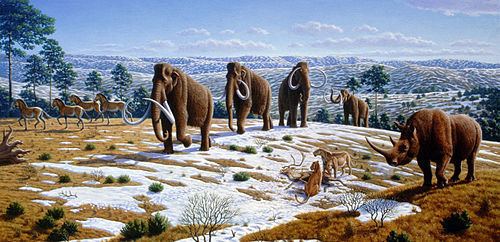 | ||
Lifespan Hippopotamus: 40 – 50 years, leopard: 12 – 17 years, Muskox: 12 – 20 years, Spotted hyena: 12 years Mass Hippopotamus: 1,500 – 1,800 kg, Leopard: 31 kg, Muskox: 180 – 410 kg, Spotted hyena: 44 – 64 kg Height Hippopotamus: 1.5 m, Leopard: 45 – 80 cm, Muskox: 1.1 – 1.5 m, Spotted hyena: 70 – 92 cm Gestation period Hippopotamus: 243 days, Leopard: 90 – 105 days, Muskox: 243 – 274 days, Spotted hyena: 110 days Speed Hippopotamus: 30 km/h, Leopard: 58 km/h, Muskox: 60 km/h, Spotted hyena: 60 km/h Length Hippopotamus: 3.3 – 5.2 m, Leopard: 90 – 160 cm, Muskox: 2 – 2.5 m, Spotted hyena: 95 – 170 cm Representative species woolly rhinoceros, cave bear, Hippopotamus, Leopard, Muskox | ||
Pleistocene megafauna is the set of large animals that lived on Earth during the Pleistocene epoch and became extinct during the Quaternary extinction event. Megafauna is a term used to describe an animal with an adult body weight of over 44 kg.
Contents
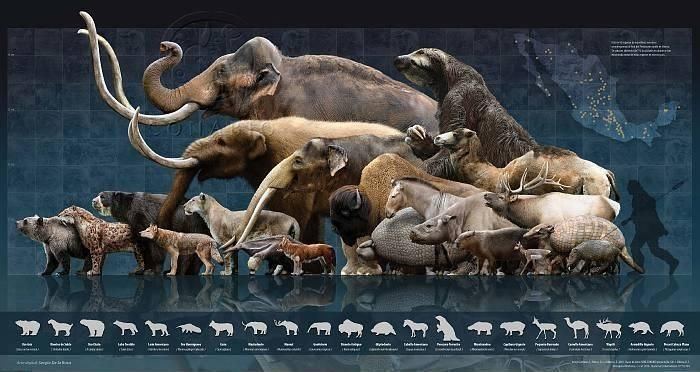
Paleoecology
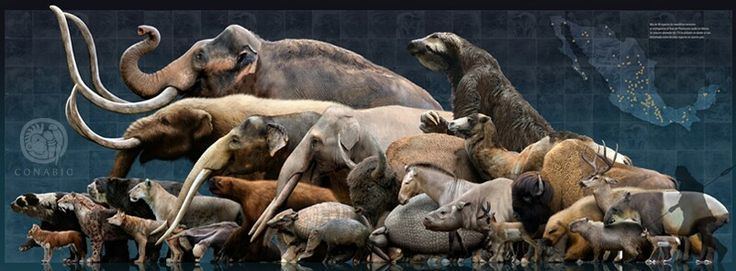
The last glacial period, commonly referred to as the 'Ice Age', spanned 125,000 to 14,500 years ago and was the most recent glacial period within the current ice age which occurred during the last years of the Pleistocene epoch. The Ice Age reached its peak during the last glacial maximum, when ice sheets commenced advancing from 33,000 years BP and reached their maximum positions 26,500 years BP. Deglaciation commenced in the Northern Hemisphere approximately 19,000 years BP, and in Antarctica approximately 14,500 years BP which is consistent with evidence that this was the primary source for an abrupt rise in the sea level 14,500 years ago.
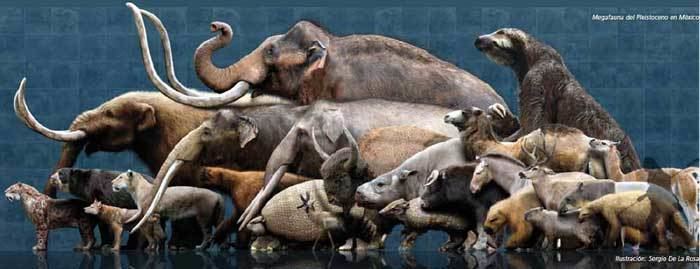
A vast mammoth steppe stretched from Spain across Eurasia and over the Bering land bridge into Alaska and the Yukon where it was stopped by the Wisconsin glaciation. This land bridge existed because more of the planet's water was locked up in glaciation than now and therefore the sea-levels were lower. When the sea levels began to rise this bridge was inundated around 11,000 years BP. During the last glacial maximum, the continent of Europe was much colder and drier than it is today, with polar desert in the north and the remainder steppe or tundra. Forest and woodland was almost non-existent, except for isolated pockets in the mountain ranges of southern Europe.

The fossil evidence from many continents points to the extinction mainly of large animals at or near the end of the last glaciation. These animals have been termed Pleistocene Megafauna. The most common definition of megafauna is an animal with an adult body weight of over 44 kg. Across Eurasia, the straight-tusked elephant became extinct between 100,000–50,000 years BP. The hippopotamus, interglacial rhinoceros (Stephanorhinus), cave bear (Ursus spelaeus), and heavy-bodied Asian antelope (Spirocerus) died out between 50,000-16,000 years BP. The spotted hyena, woolly rhinoceros and mammoths died out between 16,000-11,500 years BP. The musk ox died out after 11,500 BP, as did the giant deer (Megaloceros) with the last pocket having survived until about 7,700 years BP in western Siberia. A pocket of mammoths survived on Wrangel Island until 4,500 years BP. As some species became extinct, so too did their predators. Among the top predators, the sabre-toothed cat (Homotherium) died out 28,000 years BP, the cave lion 11,900 years BP, and the leopard in Europe died out 27,000 years BP. The Late Pleistocene was characterized by a series of severe and rapid climate oscillations with regional temperature changes of up to 16 °C, which has been correlated with megafaunal extinctions. There is no evidence of megafaunal extinctions at the height of the LGM, indicating that increasing cold and glaciation were not factors. Multiple events appear to also involve the rapid replacement of one species by one within the same genus, or one population by another within the same species, across a broad area.
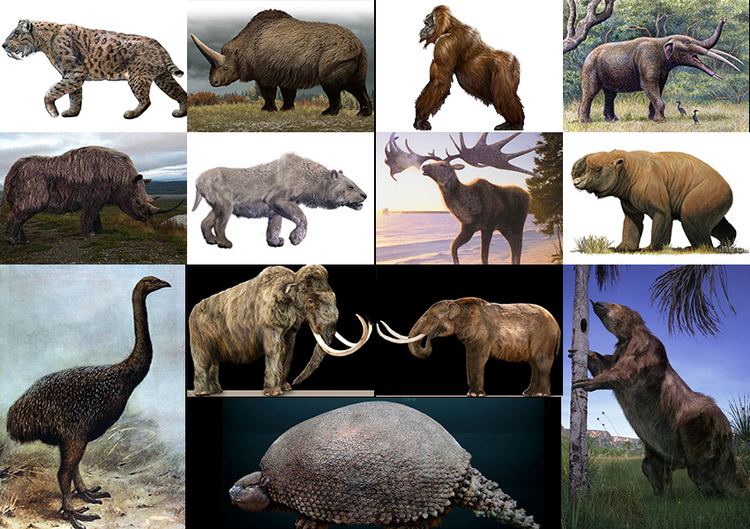
The ancestors of modern humans first appeared in East Africa 195,000 years ago. Some migrated out of Africa 60,000 years ago with one group reaching Central Asia 50,000 years ago. From there they reached Europe, with human remains dated 43,000-45,000 years BP discovered in Italy, Britain, and in the European Russian Arctic 40,000 years ago. Another group left Central Asia and reached the Yana River, Siberia, well above the Arctic circle 27,000 years ago. Remains of mammoth that had been hunted by humans 45,000 YBP have been found at Yenisei Bay in the central Siberian Arctic. Modern humans then made their way across the Bering land bridge and into North America between 20,000-11,000 years ago, after the Wisconsin glaciation had retreated but before the Bering land bridge became inundated by the sea. These people then populated the Americas. In the Fertile crescent the first agriculture was developing 11,500 years ago.
Theories
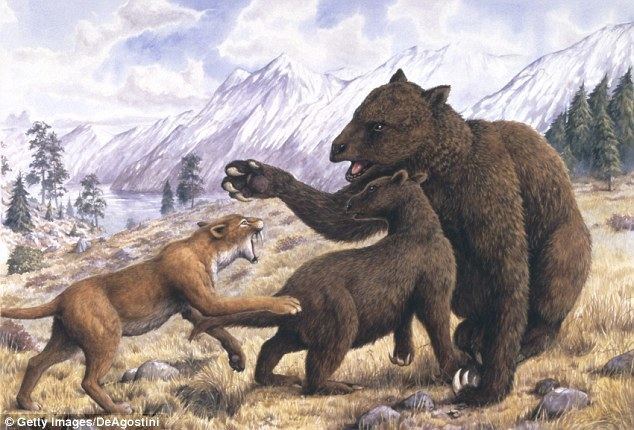
Four theories have been advanced as likely causes of these extinctions: hunting by the spreading humans, climatic change, spreading disease, and an impact from an asteroid or comet. These factors are not necessarily exclusive: two or more may have combined to cause the extinctions. Most evidence suggests that humans were responsible for these extinctions.
Regions affected
See also: Quaternary Extinction Event
North America
During the American megafaunal extinction event around 12,700 years ago, 90 genera of mammals weighing over 44 kilograms became extinct. The Late Pleistocene fauna in North America included giant sloths; short-faced bears; several species of tapirs; peccaries (Including the long nosed and flat-headed peccaries); the American lion; giant tortoises; Miracinonyx ("American cheetahs", not true cheetahs); saber-toothed cats like Smilodon and the scimitar cat, Homotherium; dire wolves; saiga; camelids such as two species of now extinct llamas and Camelops; at least two species of bison; stag-moose; the shrub-ox and Harlan's muskox; 14 species of pronghorn (of which 13 are now extinct); horses; mammoths and mastodons; the beautiful armadillo and the giant armadillo-like Glyptotherium and giant beavers as well as birds like giant condors and other teratorns. The nine-foot sabertooth salmon lived at the time as well. In contrast, today the largest North American land animal is the American bison.
South America
South American wildlife in the Pleistocene varied greatly, an example is the giant ground sloth, Megatherium. The continent also had quite a few grazers and mixed feeders such as the camel-like litoptern Macrauchenia, Cuvieronius, Doedicurus, Glyptodon, Hippidion and Toxodon. There were also Stegomastodons, found as South as the Patagonia. The main predators of the region were Arctotherium and Smilodon.
Australia
Australia was characterized by marsupials, monotremes, crocodilians, testudines, monitors and numerous large flightless birds. Pleistocene Australia also supported the large short-faced kangaroo (Procoptodon goliah), Diprotodon (a giant wombat), the marsupial lion (Thylacoleo carnifex), the flightless birds Genyornis and Dromornis, the 5-meter snake Wonambi and the giant lizard, the Megalania.
Eurasia
As with South America, some elements of Eurasian megafauna were similar to those of North America. Among the most recognizable Eurasian species are the woolly mammoth, steppe mammoth, straight-tusked elephant, aurochs, steppe bison, cave lion, cave bear, cave hyena, Homotherium, Irish elk, giant polar bears, woolly rhinoceros, Merck's rhinoceros, narrow-nosed rhinoceros, and Elasmotherium. In contrast today the largest European land mammal is the European bison or wisent.
Insular
Many islands had unique megafauna that became extinct upon the arrival of humans more recently (over the last few millennia and continuing into recent centuries). These included dwarf woolly mammoths on Wrangel Island, St. Paul Island and the Channel Islands of California; giant bird forms in New Zealand such as the moas and Harpagornis (a giant eagle); giant lemurs, including Megaladapis and Palaeopropithecus species and Archaeoindris, a gorilla-sized lemur, three species of hippopotamus, a giant tortoise, the Voay-crocodile and the gigantic Aepyornis in Madagascar; various giant tortoise species from the Mascarenes, a dwarf Stegodon on Flores and a number of other islands; ; land turtles and crocodiles in New Caledonia; giant owls and dwarf ground sloths in the Caribbean;, giant geese and moa-nalo (giant ducks) in Hawaii; and dwarf elephants and dwarf hippos from the Mediterranean islands. The Canary Islands was inhabited by endemic animals, such as some extinct; giant lizards (Gallotia goliath), giant rats (Canariomys bravoi and Canariomys tamarani) and giant tortoises (Geochelone burchardi and Geochelone vulcanica), among others.
